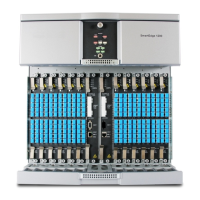Connecting and Routing the Cables
Installing the Hardware 4-33
3. Connect and route the breakout cables for the FE-GE traffic cards:
a. If it is not already open, open the door of the lower cable tray.
b. Starting with the outer slots on the left side of the chassis, attach a breakout cable to the lowest
connector to be cabled on the FE-GE traffic cards. Position the connector so that the incised label
“KEY” on the connector is on the left side of the connector as you face the chassis; see Figure 4-27.
Figure 4-27 FE-GE Breakout Cable
c. Tighten the captive screws without letting the front panel support the weight of the cable.
d. Place the cable on top of the open door of the cable tray, and route the cable to the left, regardless
of the slot in which you have installed the FE-GE traffic card; see Figure 4-28. This routing direction
is compatible with the construction of the cable (the attachment of the MRJ21 connector to the cable
itself).
e. Bundle and tie-wrap the breakout cables from the card and then tie-wrap the bundle to the rack.
f. Continue connecting and routing the breakout cables from the other FE-GE cards.
Caution Risk of equipment damage. The cable connector is keyed to ensure that you insert it with the
correct orientation into the front panel connector. However, it is possible to force an
incorrectly positioned cable connector into the connector on the front panel. To reduce the risk
of overriding the key, ensure that the incised “KEY” label is on the left side of the connector.
Caution Risk of equipment damage. A breakout cable for the 60 10/100 ports on the FE-GE traffic
cards is made of AWG #24 wire and includes individual cables for 12 ports; when connected
to the FE-GE front panel, the cable weight can cause the front panel to be separated from the
FE-GE printed circuit board. To reduce the risk, never allow the front panel to support the
weight of the cable; support the cable and immediately route it before you connect another
cable.
Caution Risk of equipment damage. Routing the cable to the right side of the chassis puts additional
strain on the front panel. To reduce the risk, never route the cable to the right.

